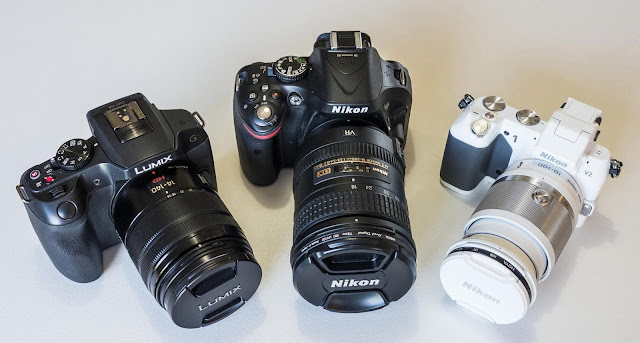 |
| End of Day. Panasonic Lumix G6 with Lumix 14-140mm f3.5-5.6 (MkII) lens |
Family Cameras Many people these days rely on their smart phone for making a photographic record of family gatherings, events, children's milestones, holidays and trips away from home. But there comes a time when some of us realise we could be making better photos with a proper camera. But which? The market is awash with so many makes and models the task of choosing one can be difficult.
The Concept of this 3 way shootout was for me to buy and use three kits, each representing a different approach to the family camera. I chose cameras which, on their specifications and promotional material appeared to be suitable for beginner/snapshooters but also had a sufficiently comprehensive user interface to engage the interest of enthusiast/expert photographers. I tested the three side by side over a two month period in a wide variety of conditions and rated each on a list of characteristics including user experience, image quality, performance and ergonomics.
Questions There are many questions and contestable assertions circulating in the world of cameras at the present time. Some of the questions, with sneak peek answers on which I will elaborate in later posts on this blog, are:
* Do Digital Single Lens Reflex (DSLR) cameras make better pictures than Mirrorless Interchangeable Lens Cameras (MILC) ? [No]
* Do larger cameras make better pictures than smaller cameras ? [Sometimes, depending on circumstances, sometimes not]
* Do larger sensors make better pictures than smaller sensors ? [Sometimes, depending on circumstances, sometimes not]
* Does Phase Detect AutoFocus (PDAF) as found on DSLR's in eye level viewing (mirror down) mode work faster or better in some way than Contrast Detect AutoFocus (CDAF) as found in many MILC's ? [No, but makes and models vary greatly]
* Do more expensive cameras give better results than less expensive ones ? [Cameras, generally yes, for the expert user. Lenses, usually yes, but not in proportion to the cost. You get more bang for your buck with the budget models]
Specification
Zoom range: Most people hate changing lenses so much they never do it. So I selected camera/lens combinations which offer an "all-in-one-do-everything-with-one-lens" solution. Inevitably that meant a superzoom lens of some kind with 10-11x zoom range.
Picture Quality: There are plenty of cameras with very small sensors (1/2.3", diagonal about 7.7mm) and fixed superzoom lenses offering 20x, 30x, 40x, 50x and even an amazing 60x zoom range. What's not to like about that ? In two words: Picture Quality. That is a composite of sensor image quality, lens quality and camera operating capability, including things like focus accuracy and stabiliser effectiveness. So I opted for cameras with a larger sensor and interchangeable lenses.
Camera Types I wanted one camera to represent the latest and best of the DSLR type, from the target "upper entry" model range. I chose one MILC from the well established M43 system and one recent MILC from the Nikon1 system, a relatively new format which has some interesting features but is not yet firmly established in the market. In each case I chose a Proper Camera with a good quality built in eye level viewfinder, functional handle, built in flash, monitor and a set of controls suitable for entry level or experienced users.
Sensor sizes I wanted one representative of each of the three sensor sizes which appear most suited to my design brief.
The Nikon D5200 has an APS-C sensor, diagonal 28mm.
The Panasonic Lumix G6 has a M43 sensor, diagonal 21.5mm.
The Nikon 1 V2 has a Nikon CX (1") sensor, diagonal 15.9mm.
The M43 sensor has approximately half the area of the APS-C sensor. The Nikon CX sensor has approximately half the area of the M43 sensor.
At the time of writing the DSLR type has been outselling MILC types in most countries, although it must be acknowleged they had an 8 year head start and when the Canon EOS D30 was introduced in 2000, the DSLR had virtually no competition from any other camera type. MILC's were introduced in the middle of the global financial crisis, facing strong opposition from the established CanoNikon DSLR hegemony, with the added burden of a collapsing compact camera market, swept away by a tsunami of smart phones.
Aims of the exercise
I wanted answers to the questions I posed above.
I hoped to discover which kit and more generally which camera type best fulfilled my functional design brief. [Sneak peek: it's the M43 MILC]
I wanted to gain a sense of direction for the future of the camera as a useful tool. [Sneak peek: it's MILC's for the next few years and after that maybe superzoom cameras with fixed big zoom lenses and much better picture quality than the ones currently available]
Author's statement of interest I have no dog in this race at all. I have over the last 60 years used almost every make and type of camera ever invented. I have no affiliation with any maker or vendor of photographic equipment. I am comfortable using any kind of camera from large format through SLR, DSLR, to MILC and Compact.
My current personal choice of camera gear is a Panasonic Lumix GH3 with 12-35mm f2.8 and 35-100mm f2.8 zoom lenses. In the last three years I have owned, used and reviewed on this blog DSLRs from Canon and Nikon, MILCs from Panasonic, Olympus, Samsung and Nikon and advanced compacts from Canon, Panasonic and Fujifilm. The equipment used in this 3 Way comparison was all purchased retail by me in Sydney at over the counter prices, GST paid.
Why do I do it ? The exercise is expensive and time consuming. One day I will stop testing cameras and get on with life. But at the moment I am recovering from major surgery and my range of activity is restricted, so this 3 Way comparison test is something of interest to me which I can manage. I hope readers of this blog will find the material relevant to their own questions about camera equipment and use.
Next: The weigh in: Dimensions, description and features.
